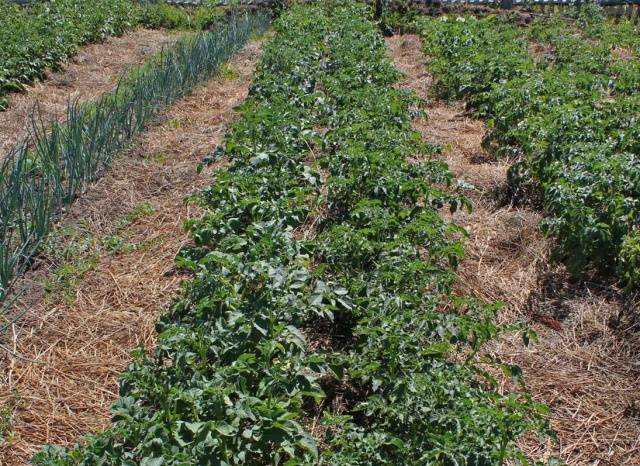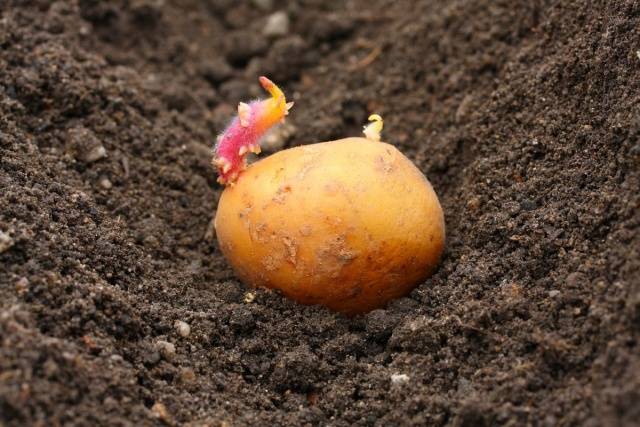Content
As you know, early-ripening potatoes have two big drawbacks: mediocre taste and poor keeping quality. Usually, early potato varieties farmers and summer residents grow them in small quantities, just to enjoy the tender young potatoes. The Lady Claire variety is a mid-early potato, but this potato is considered one of the most delicious and has a long shelf life. The Dutch hybrid also owes its popularity to its high yield, excellent commercial qualities, relative unpretentiousness and durability. The variety really deserves the closest attention of gardeners.
Full characteristics of the Lady Claire potato variety, reviews and photos of bushes and tubers - all information is collected in this article. Here the advantages and disadvantages of the Dutch hybrid will be listed, where it is best to grow it and what to pay special attention to.
Description of the hybrid
Lady Claire potatoes were bred by breeders from the Netherlands. The original name of the hybrid is Lady Claire. The variety is recommended for cultivation on an industrial scale and in private farms. Lady Claire is included in the State Register of Agricultural Crops; these potatoes are proposed to be grown in the Central and North Caucasus regions.
Full description of the Lady Claire potato variety:
- early ripening periods - the growing season is 65-70 days (the first root crops can be dug up 1.5 months after the bushes germinate);
- medium-sized bushes - up to 50 cm in height;
- shoots are erect, well leafy;
- stems are powerful, not prone to lodging;
- leaves are wrinkled, large, emerald green, with wavy edges;
- the corollas are compact, the flowers are white, no berries are formed in their place;
- the root system is powerful, under one bush, on average, 10-12 tubers are formed;
- There are very few small and deformed potatoes - Lady Claire has a very attractive and highly marketable appearance;
- the shape of the tubers is oval, leveled;
- potatoes weigh from 80 to 120 grams;
- Lady Claire's peel is light yellow, quite dense, but thin;
- the pulp is yellowish-white, also of high density;
- There are few eyes on the potatoes, they are small and shallow (the Lady Claire variety is suitable for machine washing and peeling);
- the taste characteristics of potatoes are high – 4 out of 5 points;
- Lady Claire tubers contain a lot of starch (about 15%), carotene and vitamin C;
- taste Dutch potatoes pleasant, but not very rich (like all early varieties);
- potatoes cannot be called watery, the tubers have a high content of dry substances (at 21%), Lady Claire's boilability is average;
- Almost any soil is suitable for growing this potato, but the variety shows the best yield on fertile chernozem or sandy soils (Lady Claire bears fruit worst of all on heavy clay soils);
- the yield of Dutch potatoes is high - at the level of 140-180 centners per hectare (with proper agricultural technology, it is possible to increase the indicators to 270 centners / ha);
- the keeping quality of potatoes is excellent, which is unusual for early varieties - at the level of 94% (tubers can be stored in basements for up to six months);
- during storage, the taste of Lady Claire tubers does not deteriorate and their appearance practically does not suffer;
- Thanks to the dense pulp and durable skin, the potatoes tolerate transportation well and are not afraid of shocks and other mechanical influences;
- the variety is very resistant to a number of dangerous “potato” diseases;
- Lady Claire tolerates drought relatively well and does not require frequent watering.
Pros and cons of Dutch potatoes
Reviews from domestic gardeners about the Lady Claire Dutch potatoes are mostly positive. In Russia, these potatoes are loved for the following qualities:
- excellent yield, sufficient for industrial cultivation;
- resistance to major crop diseases;
- low susceptibility to pests;
- good taste;
- possibility of long-term storage;
- unpretentiousness in planting and care;
- universal purpose of potatoes;
- presentation of tubers;
- resistance to drought and high temperatures;
- high nutritional value of potatoes;
- Lady Claire's suitability for transport;
- early ripening.
Another big advantage of the Lady Claire variety is that potatoes do not degenerate for a long time: you can plant these potatoes in one area for many years and get decent yields from year to year.
The Lady Claire variety has no major drawbacks. Some farmers complain about the shrinking of tubers and excessive hardness of the potatoes. As practice shows, this happens due to insufficient moisture: although Dutch potatoes tolerate drought normally, but only if it is short-term. Therefore, you will still have to water the area with potatoes.
Diseases and pests
The Lady Claire potato variety has good immunity to most diseases and is practically not afraid of pests - this potato is one of the most resistant.
According to the findings of researchers and reviews from gardeners, Lady Claire has high resistance to a number of diseases:
- golden cyst nematode;
- potato cancer;
- blackleg;
- potato rhizoctonia;
- common scab;
- apical gray rot;
- tuberous rot.
To prevent the development of late blight, which is one of the most dangerous diseases of nightshade crops, it is necessary to constantly monitor the degree of soil moisture. The Lady Claire potato variety will withstand drought better than excessive moisture!
Potatoes have a fairly thick skin, so Lady Claire tubers are not afraid of wireworms, slugs, mole crickets and Colorado potato beetles.But potato bushes must be protected from pests; for this they are treated with insecticides a couple of times.
In order not to create a favorable environment for the emergence and proliferation of infections and pests, you need to monitor the plantings. Lady Claire potato row spacing is regularly weeded, removing weeds and loosening the ground. To make his work easier, a gardener can use mulch: mown grass, hay, sawdust will prevent excessive evaporation of moisture and protect against the germination of weeds.
Agrotechnical techniques
There is nothing difficult about growing Dutch potatoes. The Lady Claire potato variety can be planted both in open ground and in a greenhouse (relevant for northern regions). Any soil will do, as long as it is loose and nutritious and does not retain moisture.
The technology for planting potatoes is proposed as follows:
- A couple of weeks before planting, potato tubers should be brought to a warm place for germination. You can germinate Lady Claire potatoes in the sand or in the open air.
- Immediately before planting, it is recommended to treat potatoes with special chemical compounds or a solution of potassium permanganate. This will protect the tubers from pests.
- The soil on the site must be loosened in advance, weeds and their roots must be selected, and fertilizers must be spread (peat, wood ash, humus).
- The recommended planting pattern for the Lady Claire variety is as follows: 35x60 cm. The depth of the holes should not be more than ten centimeters, since in this case the tubers may rot even before germination.
Rules of care
Lady Claire potatoes are not capricious, so caring for them is easy:
- Hill up the sprouted bushes, forming high ridges around them (as in the photo below);
- water during periods of prolonged drought, avoiding waterlogging of the soil;
- fertilize the bushes once with mineral compounds based on potassium and phosphorus (this is best done before the Lady Claire potatoes bloom);
- you can carry out foliar treatment of potatoes with superphosphate dissolved in water (this should be done a couple of weeks before harvesting);
- treat potato bushes with insecticides, monitor the health of the plants;
- Weed the rows regularly or use organic mulch.
The dug up potatoes must be dried. To do this, the tubers are laid out at the edge of the plot or under a canopy. After some time, the potatoes need to be sorted and removed for storage.
Review
Conclusion
The Lady Claire potato variety can safely be called universal. These potatoes are suitable for growing in open ground and in greenhouses; they can be consumed in their original form or processed; most importantly, the crop is suitable for storage, although the appetizing tubers are often eaten while still young.
Lady Claire rarely gets sick, produces abundant harvests, and also does not degenerate, so farmers can grow potatoes from their own seeds for several years.






















